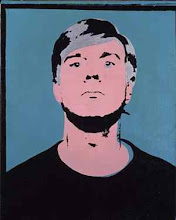 |
|
The Fernsehturm (detail), Alexanderplatz,
Berlin
|
Day 1 of
a week in Berlin with BA Fine Art and MA Visual Communication students from the University
of Gloucestershire. We began our visit with a with a walk through
the old Jewish areas of Mitte to see Karl Biedermann's 1996 bronze
sculpture, Der verlassene Raum (The Deserted Room)
in Koppenplatz. The slightly oversized table and chairs (one overturned),
ringed by a poem by Nelly Sachs is a memorial to the families who
fled their homes as the Nazis attacked during Kristallnacht
(9-10 November 1938).
On the
way we passed a distinctively un-gentrified block on Linienstrasse - this is a,
now legalised, squat.
Nearby,
in Grosse Hamburger Strasse, site of the Jewish Cemetery, is The Missing House by Christian Boltanski. A gap in the houses was created by allied
bombing on 3 February 1945. Boltanski has mounted 12 plaques onto the facing
walls of the surviving buildings on either side of the gap showing the names, occupations and dates of residency of the people
who had lived in the bombed apartments.
Amongst
the cobbles of Grosse Hamburger Strasse (and many other streets in Berlin and
other cities) are rather wonderful 'Stolpersteine'
('stumbling blocks') - the work of Gunther
Demnig. These modest, brass-faced, cobble-stone sized, concrete
blocks memorialize individual victims of the Nazis at the places where they
lived. In the picture, below, for example, the right hand Stolperstein reads
"Here lived Joanna Klum, born Lewin 1902, deported 1943, murdered in
Auschwitz."
Our walk
took us to Hackescher Markt from where we caught an S-Bahn
to Ostbahnhof which is a short walk from the East
Side Gallery, the spectacularly painted 1.3km long remnant of the Berlin
Wall - though disappointingly much of the wall is currently behind a
protective fence.
A ride on
the U-Bahn from Schlesisches Tor, and a short walk, led us to the Jewish Museum. Daniel
Liebskind's extraordinary extension to the museum was completed in
1999. Liebskind's building appears to be detached from the older buiding to
which it is an extension; it also has no visible entrance. Visitors must enter
through the old building and via an underground passage - a metaphor for the
difficulty of entering into the troubled history represented in the museum. The
extension is in the form of a zig-zag - apparently a "dislocated Star of
David... that is visible only from the air" (see Jacobson). I found that I had little sense of the
shape of the building from inside it, however, the slanting corridors which
form the internal 'axes' were effectively disorienting.
 |
|
Aerial view of the Jewish Museum
|
The most
dramatic and affecting features are the 'Holocaust Tower' and the installation Fallen Leaves in the 'Memory Void'. You
enter the Holocaust Tower through a heavy door and find yourself in a cold,
dark, bare concrete space, some 79 feet high, lit only by a narrow window slit;
the walls converge into a narrow space into which visitors disappear. It is
very powerful.
 |
|
Inside the Holocaust Tower
|
The
Memory Void, contains an installation called Shalekhet (Fallen Leaves)
by Menashe Kadishman: it comprises 10,000 faces
punched into steel plates covering the floor, many layers deep. Visitors walk
across the uneven surface of faces causing the steel plates to clang. Also very
powerful.
A short
distance from the Jewish Museum is the Berlinische
Galerie - Museum of Modern Art.
 |
|
Berlinische Galerie with the 'Yellow
Field of Letters' by architects
Kühn Malvezzi |
The
museum offered a dizzying range of exhibitions - quite simply too much to do
justice to in the time available:
 |
|
Rainer Fetting, Gelbe Mauer, 1977
|
 |
|
Max Beckmann, Self-Portrait, 1907
|
This is Us: Portrait Photography, 1996-2013; a group show featuring work by
Max Baumann, Kristleifur Björnsson, Dunja Evers, Verena Jaekel, Birgit Kleber,
Boris Mikhailov, Loredana Nemes, Michael Schäfer and Tobias Zielony.
 |
|
Loredana Nemes, Max and Corinne,
2012
|
 |
|
Dunja Evers, Portrait
|
Ich kenne kein Weekend (I know no weekend): the Archive and Collection of René Block: a fascinating collection of documents, posters and videos featuring, notably, Joseph Beuys and Wolf Vostell.
 |
|
Joseph Beuys, I Like America and
America Likes Me, 1974. Watch video, here
|
12×12: a changing
programme of film and video work presenting
the work of 12 artists through the year. The featured artist at the time of our
visit was Jan Peter Hammer showing The Anarchist Banker (2010) and Monarchs and Men (2012). I really regret not
giving more time to this installation. I watched only a few minutes of The
Anarchist Banker before feeling compelled to see as much of the museum's
collection as I could before time ran out. In hindsiight I wish I had
prioritized this fascinating work.
The films
do not appear to be online but some clips are included in this interview: https://vimeo.com/60120145
 |
|
Jan Peter Hammer, still from Monarchs
and Men, 2012
|











No comments:
Post a Comment